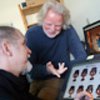Marco Polo is learning to walk now

If a book such as “Die drei Freunde” (“The Three Friends”) by Helme Heine is particularly popular among children, or an adventurer such as Marco Polo still keeps children in suspense, then this is also the stuff which his dreams are made of for animated cartoon film producer Tony Loeser. His firm MotionWorks has demonstrated expertise in the field of animation for almost 15 years. The films produced in the Halle studios are often created in co-production with foreign partners and have interested parties worldwide. The predetermined time phases entered in the “Marco Polo” production plan are colourful. The plan hangs large in the office of the “creative economists”, as Tony Loeser describes his colleagues. They plan a production and then have to ensure that time and budget will be adhered to and the productions from MotionWorks will be finished in time, especially when it involves an international co-production such as with “Marco Polo”. The script is being written in Canada, and works on the 3D designs for the background are starting this month in Luxembourg. The Irish will be working on the animation. But first of all the pilot episode, the first of 26 “half-hour episodes” will be completed in Halle.Tony Loeser leads into the “Marco Polo” workshop, past doors which lead to “Ringelgasse 19”, “little polar bear”, “Kikaninchen” the little blue rabbit or the three friends from “Mullewapp” (“Mollywoop”). Behind each of these doors is a specially compiled team that only takes care of this one animation film. Animation films are usually created on computer nowadays, i.e. on the digital sketch block. Yet it is hard to imagine animation production without artistic skill. The images are still handicraft in the truest sense of the word. It is just that the helpers are an electronic pen or a computer mouse.Sketches are being diligently drawn in the Marco Polo nursery. The characters are born here. They take on shape here and learn their first footsteps. Graphic joints on which the animation can start are inserted so that they can move.The style-determinant fundamentals are also researched here in the studio. In this case this involves the world in Marco Polo’s lifetime. After all, the characters – as well as how they look and how they dress – are supposed to fit in that era. The buildings as well as the everyday objects also have to be in keeping with the period. Then the researched models will be translated in the style of the series. This is aimed at eight to eleven year-olds. “They travel together with Marco Polo through his world and also take such a fascinating adventure journey into history”, says Tony Loeser. Well, is there no mobile phone in Marco Polo’s luggage? Loeser shakes his head. “We are rather conservative in our approach. The series shall also be running in 25 years.” That is why the graphic style of the series should above all be rather timeless, says Loeser.In particular, the Little Sandman or Maya the Bee or naturally the Disney films prove that this works with children’s films. “For generations nothing has changed in the narrative structure for children”, says the experienced animated cartoon film producer knowingly. “The dramaturgies remain the same because children also remain the same. They are curious, full of imagination and enjoy stories told in a suspenseful manner.”Tony Loeser – 58 years old and meanwhile himself a grandfather – had collaborated in children’s films as a film and television cameraman at DEFA and became self-employed after German reunification with the “Ostfilm” enterprise. Starting in 1998, because of the Central German Media Fund (MDM) in Leipzig he also established the “Mitteldeutsche Talentschmiede” (“Central German Talent Factory”), founded MotionWorks GmbH together with his colleague Romy Roolf, and then went to Halle – “not least because of advertising and due to the strong commitment of several people from Saxony-Anhalt”, says Loeser. Up to then, the animation film genre was not a tradition here. “Many people grinned about us”, says Tony Loeser. In the meantime, MotionWorks ensures that Saxony-Anhalt – even the city of Halle – will be appreciated internationally in the film industry. Animated cartoon films are produced according to international standards on a high technical level as well as in terms of content. Several television stations are partners.Tony Loeser decisively negates the question regarding whether partners for co-productions are sought via the Internet. This is a person-to-person business. “A production takes between three and five years”, says Loeser. That is it must be examined beforehand whoever makes such a long-term commitment. “This is like in a marriage. You also have to be willing to get through boisterous phases and partially difficult problems with each other. And yes, this concerted working time is also the lifetime of every single individual. You just do not want to get angry here.” Tony Loeser looks over the shoulder of his Marco Polo co-director Lutz Stützner, more for the photo to go with this article than to control his work. Stützner is one of the old hands in the animation film business, but very new in the MotionWorks team. In addition, co-founder Romy Roolf – here as well as with other projects the executive producer – is a seasoned veteran in the business. With such experienced experts in the regular family of colleagues the company can also repeatedly obtain young people in order to bring fresh, healthy wind into the studios.MotionWorks currently has 25 salaried employees and 50 to 80 freelancers, depending on the order situation.Twelve designers are working on “Marco Polo” at the moment. There will be even more by the end of the production time in one and a half years. Then “Marco Polo” can be seen on the German “Children’s Channel” (KiKA). The series is an ARD/MDR co-production. Author/photo: Kathrain GraubaumContact: MotionWorks GmbHMansfelder Straße 5606108 Halle/Saaleph: +49 345 20569E-mail: office@motionsworks.euWeb: www.motionworks.eu

